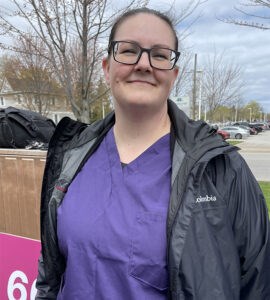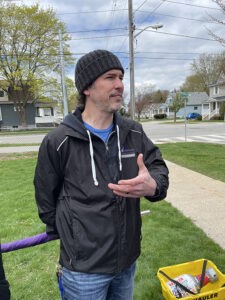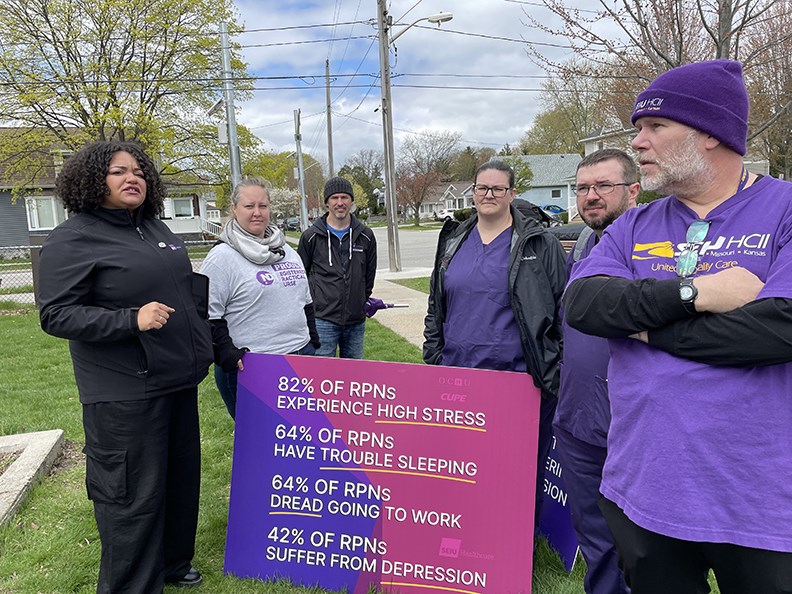RPN Catherine McAnally says it’s often chaos when she arrives for her shift at Bluewater Health.
“We have to go straight into that chaos,” she said. “Someone could be coming back from an OR not doing the greatest and, if I feel I can’t take care of that patient, I have to find an RN…There’s a problem right there (if the RN already has her ratio of patients).”

Juggling patient care and ensuring no one is overlooked is increasingly difficult, McAnally said. “We are ready to fight (for better wages and better patient care).”
Patient-to- RPN ratios should be 4:1 but are closer to 7:1, dropping to 10:1 in the evening at Bluewater Health, McAnally said.
She was joined by half a dozen union reps speaking out Wednesday about what they called unsafe working conditions, poor patient/RPN ratios and insufficient pay.
They gathered at the corner of Maria and Russell streets to draw attention to a new poll that highlights existing RPN shortages in Sarnia and the rest of Ontario.
The poll was conducted by SEIU Healthcare and CUPE, in partnership with Nanos Research, and surveyed 1,000 Ontario RPNs (Registered Practical Nurses), including RPNs in Sarnia. It found short staffing, resignations, burnout, violence and dangerous working conditions are driving RPNs to quit their jobs.
“The poll is really jarring,” said Jackie Walker, an RPN and SEIU nursing division president from Toronto who came to Sarnia to support local workers.
Six in 10 RPNs are considering leaving the profession, according to the poll. “But 80% of those RPNs would stay if they were compensated in a more appropriate way,” Walker said.
Ontario’s 46,252 RPNs currently earn $31.80 an hour at the top of the pay scale while a top paid RN makes $48.17 an hour, said Walker.
That’s despite the fact RPNs are increasingly being asked to take on responsibilities previously limited to RNs, said RPN and chief SEIU steward Tim Allen. And they are being asked to take on additional duties with very limited training, Allen added.
RPNs across Ontario, including the 331 at Bluewater Health, want the Doug Ford government to provide a “universal” wage to all RPNs of $35 an hour.
Some RPNs at municipal long term homes are paid $35 an hour but no others earn that much, Walker said.
“It is about money but it’s more about the care that nurses aren’t able to give to their patients when you work short-staffed every day.
“There are not enough RPNs on the floor at the bedside to give the care that people in Sarnia deserve,” said Walker.

The information picket in Sarnia was held prior to a May 10 mediation meeting when union reps are scheduled to sit down with government officials specifically to discuss pay for RPNs, said Andy Brake, an SEIU executive board member and Emergency Response Officer at Bluewater Health.
RPNs are considered essential workers and can’t strike but can hold information pickets to let the public know what’s going on, said Brake.
“We have two years of education (compared to Registered Nurses who have four years of education),” McAnally said. “They have a higher scope than we do but now the RPNs role is changing.”
The hospital provides “quick, in-house training and we’re able to do stuff…that RNs should be doing,” she said. “They are trying to increase our workload but say they won’t give us any more money, but also increase the number of patients too.”
“We look at the RNs and we say you’re getting all that money and I’m doing 90% of the work you’re doing,” Walker said.
